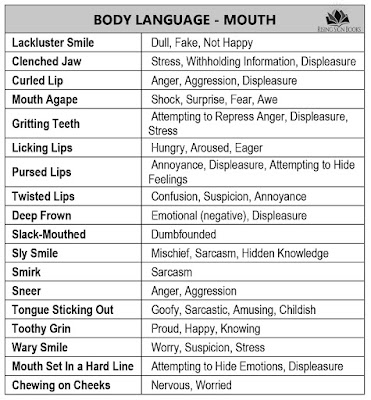Body Language plays a huge part in Showing vs. Telling.
The unspoken elements of body language are one of the elements that can truly make the character feel well rounded and believable. So we’re going to take the next few minutes to show examples of these elements, how they are described, and what meanings they hold, both for the character acting them out on the page, and the reader inferring their meaning.
Let’s look at the key parts of the body and how their movement equates to meaning. Then we’ll go into how they work together to become the unspoken but very much understood language of emotion.
THE HEAD
A nod, bob, tilt, or shake can mean a variety of things.
THE FACE
Our face tells a lot about how we are feeling. The way we curl our lips, hold our head, or the way we avoid looking at things reveals what is going on under the surface. Take a look at these examples below to see how each description correlates to its meaning.
EYES
The eyes are more than just a colorful element to the face. The way they move can tell us a lot about what a character is thinking, or what they may be hiding in contrast to how they speak. With a wink or a blink, you can convey interest, anger, and much more.
MOUTH AND JAW
The lips and jaw are very revealing features. The way you use them can convey happiness, sadness, or secretiveness. Do you chew your lips when you’re nervous? Do you clench your jaw when you’re stressed? These descriptive additions can help emphasize the emotions that a character may not reveal through speech.
HANDS, ARMS, & SHOULDERS – UPPER BODY
We move various parts of our body to emphasize or some-times hide how we feel. Body language experts can tell you what a person is not saying just by how they move. You too, as the author can use these clues to reveal what is going on under the surface when your characters are interacting with each other.
LEGS, FEET, & POSTURE – LOWER BODY
When a character’s body is in full view, whether sitting or standing, the way they hold themselves reveals a variety of important clues.
THE VISUAL EMOTIONS (BODY LANGUAGE) CHEAT SHEET
This is by no means an exhaustive list of traits belonging to each emotion, nor is it a complete list of emotions. It is meant to give you a base to pull from when attempting to show the unspoken elements that relate to the emotions your character may be feeling.
This is what I often refer back to when revising my work to add more emotional clues. If you want to learn more tips and tricks to make your writing sizzle, check out Write and Edit The Damn Book!









